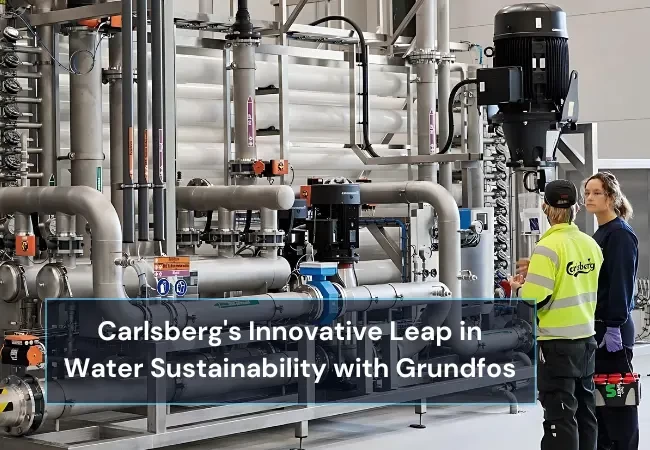Carlsberg's Innovative Leap in Water Sustainability with Grundfos
At the heart of brewing lies a fundamental ingredient: water. For Carlsberg Brewery, managing this precious resource effectively is key to their ambitious sustainability goals. As part of their Zero Water Waste initiative, Carlsberg aims to cut its water use by 50% by 2030. Their approach, integrating advanced technology and collaboration, is exemplified by their groundbreaking Total Water Management (TWM) plant in Fredericia, Denmark—a project significantly supported by Grundfos.
The Water Challenge in Brewing
Water plays a pivotal role in beer production, but not all of it ends up in the final product. At Carlsberg's Fredericia facility, approximately 60-65% of the water used is dedicated to cleaning—this includes everything from equipment and surfaces to bottles and tanks. This significant volume of process water, while crucial for maintaining hygiene, historically has been seen as an indicator of cleanliness. However, this notion is evolving.
In 2015, Carlsberg used 3.4 liters of water per liter of beer produced. Their goal now is to reduce this to less than 1.7 liters by 2030, as part of their broader Together Towards Zero sustainability program. Achieving this requires more than incremental improvements—it calls for a transformative approach to water management.
A Vision Realized Through Collaboration
The journey towards a more sustainable water usage began with a visionary collaboration within the Danish Partnership for Resource and Water-Efficient Industrial Food Production (DRIP). This partnership includes businesses, technology providers, research institutes, and regulatory authorities, all working together to advance water reuse and purification technologies.
In 2019, Carlsberg, in collaboration with Grundfos and other partners, embarked on the ambitious project to build a demonstration facility known as the Total Water Management (TWM) plant. The goal was to develop a system that could recover and recycle process water on a large scale—an endeavor that Carlsberg’s Brewing Director, Anders Kokholm, describes as a long-held aspiration now coming to fruition.
The TWM Plant: Turning Waste Into Resource
The TWM plant at Carlsberg’s Fredericia facility represents a significant leap in water sustainability. The core idea is to treat and purify process water from cleaning operations to drinking water quality and reuse it within the brewery. This approach not only conserves water but also enhances the overall efficiency of the plant.
The plant is capable of treating 2,000 cubic meters of process water daily, with an impressive 90%—or 1,800 cubic meters—being recovered and recycled. The treated water undergoes a sophisticated process involving:
- Anaerobic and Aerobic Treatment: Initial stages of wastewater treatment use biological processes to break down organic matter and remove pollutants.
- Membrane Bioreactor (MBR) Filtration: This step further removes solids and contaminants.
- Reverse Osmosis (RO): The water is then purified using closed-circuit reverse osmosis to eliminate dissolved salts.
- Re-Mineralization: Calcium carbonate is added to stabilize the water and ensure it meets drinking water standards.
- UV Treatment and Chlorine Dioxide Injection: Finally, UV light and chlorine dioxide are used to ensure the water is free from bacteria and to prevent biofilm formation.
Grundfos: A Key Partner in the Process
Grundfos, a leader in pump and water technology, played a critical role in the TWM project. Their expertise in pumping and dosing solutions was essential for the plant’s success. Grundfos supplied 95% of the pumps used throughout the plant, ensuring precision and reliability in water treatment processes.
“Grundfos brought invaluable know-how to the project,” notes Bryan de Bel, Project Manager at Pantarein Water, the company responsible for providing the full treatment system. “Their solutions were chosen for their durability, efficiency, and ability to monitor and control the system effectively.”
Grundfos’s advanced pumping technology allows for efficient water movement and precise dosing, which is crucial for maintaining the plant’s high standards of water quality. As Søren Nøhr Bak of NIRAS points out, “Grundfos’s solutions provided the reliability and intelligence needed to ensure the smooth operation of the plant.”
A Sustainable Future
Carlsberg’s TWM plant is more than just a technological achievement; it represents a significant step towards a more sustainable future in the brewing industry. By recovering and reusing process water, Carlsberg not only meets its ambitious sustainability targets but also sets a benchmark for other industries to follow.
The integration of Grundfos technology into the TWM plant highlights the importance of collaboration and innovation in achieving environmental goals. As Carlsberg continues to advance its sustainability efforts, the successful implementation of the TWM plant serves as a testament to the potential of combining cutting-edge technology with a commitment to resource efficiency.
Grundfos Solutions from Alantech
When it comes to Grundfos solutions, Alantech, a leading water treatment manufacturers, stands out as the best choice.
Grundfos have a variety of solutions and the complete product range is designed to meet the diverse customer needs. As the best Grundfos pumps dealer and distributors, Alantech has in-depth knowledge about Grundfos products. Alantech can help customers choose the best product that will perfectly align with their budget and requirements. As a trusted partner of Grundfos, Alantech offers top-notch solutions and ensures customer needs are satisfied.


